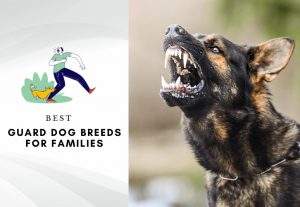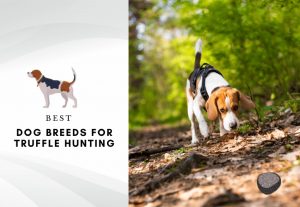It’s no secret that the world has become a more dangerous place. The best way to protect your family and house from intruders, as well as other animals that might be detrimental to your property, is with a guard dog breed.
There are so many breeds out there, it can be hard to choose which one is best for you. With this detailed guide, I will help you narrow down the list by providing a list of 10 great guard dogs for families!
So, if you’re considering adopting a protection dog breed to protect yourself and your home, I’m sure this guide will clear up any doubts you might have.
What Are The Best Guard Dogs for Families?
The best guard dog breeds for families and protection are:
- Bullmastiff
- Belgian Malinois Dog
- German Shepherd
- Doberman Pinscher
- Cane Corso
- American Akita
- Argentine Dogo
- Maremma Shepherd
- Giant Schnauzer
- Rottweiler
Why You Should Consider Getting a Guard Dog?
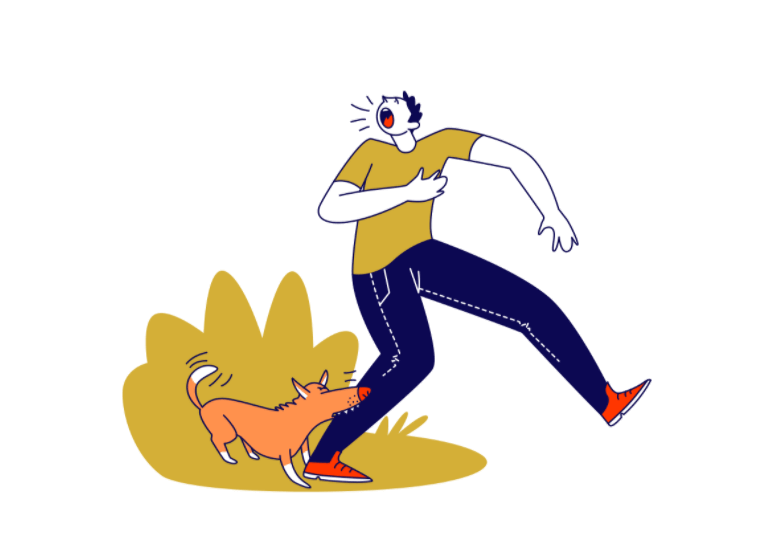
In this day and age, safety is everyone’s priority.
I don’t like to be pessimistic about people, but every now and then, you definitely get the feeling that the world is becoming an increasingly unpredictable place.
In any case, to sleep more soundly and have a constant security presence, there is an excellent solution: adopt a guard dog.
For guard dogs, I mean all those specimens belonging to breeds that can be trained to fulfill this task, that of a guardian.
In most cases, these dogs boast centuries, if not millennia, legacy of breeding, selection, and training for this purpose, for which they are naturally suited.
A good watchdog will not only protect your home and family members in case of danger, but will constantly watch over the status of its territory, will not fail to alert you to a perceived risk, and will be deeply bonded to its pack members.
In short, if the safety of your person, your loved ones, or your property is a sticking point that you can’t help but worry about, a good guard dog could really be for you.
Of course, but I hope there is no need to specify this; even if it is an animal dedicated to the work of protection, it is still a dog: attention, care, and love must never be lacking.
Moreover, don’t think that a breed indicated as a guard dog, as soon as it is introduced in the context of the house, will start of its own accord to behave accordingly.
All dogs, especially the guard dogs, need rigorous training and careful socialization so that their nature can express itself at its best in a balanced and obedient way.
If you find that such a dog can be a valid helper to keep you safe, as well as an inseparable life companion, continue reading this article and discover some of the best family guard dog breeds.
Top 10 Best Family Guard Dogs Breeds
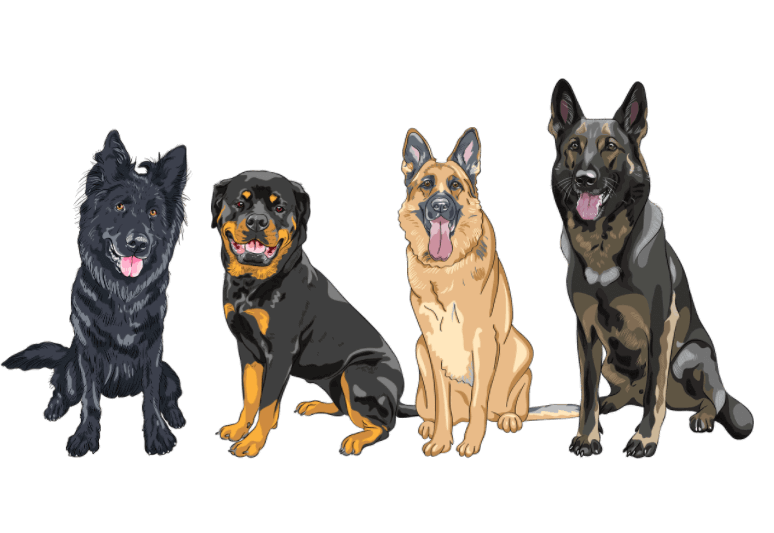
All guard dogs, despite the differences between them, show some common and quite developed characteristics.
First of all, it is without any doubt the attachment to the owner and to the family in general and strong territoriality, which manifests itself in the hostility towards unwanted intruders.
But that’s basically the prerequisite for any self-respecting good watchdog.
Another factor common to all these breeds is the need for an experienced or otherwise knowledgeable owner to manage them.
The education, socialization, and training of all these guard dogs are, in fact, not a walk in the park, for some more and for others less, and ALL of them will need a firm, confident and consistent guide who can prove to be a real pack leader.
The specific ways and interactions to be developed with the animal then vary from breed to breed.
However, there are also numerous differences between these breeds, so that one might be preferable to the other for some owners.
Greater territoriality may be preferable in some contexts, while greater adaptation to indoor life and family companionship may be preferable in others.
In short, it all depends on your needs as a dog owner, and it’s up to you to choose the breed that best suits those needs without expecting to upset the dog’s nature.
Moreover, when you’re working out which breed of a guard dog will be right for you, make sure with a good dose of self-criticism that you’ll be able to stand up to the commitment you’re making: only in this way will you be able to give yourself, your loved ones and your future dog a happy and peaceful life.
1. Bullmastiff
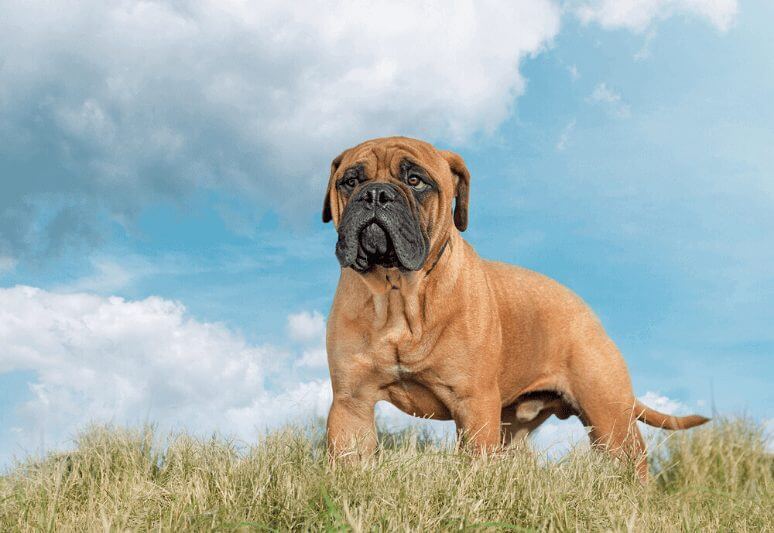
The Bull Mastiff, or Bullmastiff, is a guard dog of English origin, selected from the crossbreed of the English Mastiff and the Old English Bulldog.
The Mastiff can reach 26.7 inches (ca. 68 cm) in height at the withers and 130 pounds (ca. 59 kilogram) in males, reaching 26 inches (ca. 66 cm) in height and about 110.2 pounds (ca. 50 kilogram) in weight in females.
In short, this is certainly not a small dog for a studio apartment.
The Bullmastiff, officially recognized as a separate breed in 1924, has a powerful and fearsome physical structure but is endowed with a rather mild and balanced temperament.
In addition to being an irreducible lover of family company, this dog is a guarantee against unwanted intruders but without showing excesses of impulsiveness or aggression.
If trained correctly and rigorously, if socialized early and abundantly, and if treated with respect and love by the whole family, the Bullmastiff will not only prove to be a perfect housekeeper but also an inseparable life companion.
Bullmastiff Guarding Aptitude
Excellent aptitude for master, family, and property defense.
If properly trained for this task, it will be able to distinguish, always with the help of the master, what represents a danger and what does not.
In addition, the Bullmastiff is a dog with great self-control and a truly well-calibrated use of bite.
Bullmastiff With Children
Bullmastiffs are sweet, caring, and affectionate dogs towards children.
They are able to bond and be very patient with them, taking them under their protective wing.
Given the size of the dog, however, it is good to be vigilant about their interactions with younger children.
Bullmastiff With Strangers
The Bull Mastiff is a dog that is naturally wary of strangers, especially those not introduced to him by his owner.
In order to avoid these dogs developing a real aggressiveness towards strangers, it is good to make them socialize with other human beings since they are young so as to soften this harder side of theirs.
Bullmastiff With Master and Family
The Bullmastiff is a dog that is extremely attached to its family members, both the owner and others.
With them, he demonstrates a deep bond of love and affection, feelings that he will seek and expect to receive in return for his loyalty.
It is, in fact, a born puppy, perfect for the warm family nest.
Bullmastiff With Other Dogs
The Bullmastiff is a dog that is generally tolerant and sociable towards its peers despite its brutish appearance.
However, what it will tend to do is to impose itself as a dominant individual, and this, especially with other males of similar size, could lead to serious problems.
Good socialization and special attention to circumstances are always required.
Bullmastiff Aggressiveness
The Bullmastiff is generally a tame animal but is very wary, so it can react in a very hostile manner if it feels threatened.
However, it is difficult for it to be aggressive without good reason unless it has been mistreated or poorly trained, despite a certain tendency to stalk prey and resort to biting playfully.
If well socialized, however, the Bullmastiff is not an aggressive dog.
2. Belgian Malinois Dog
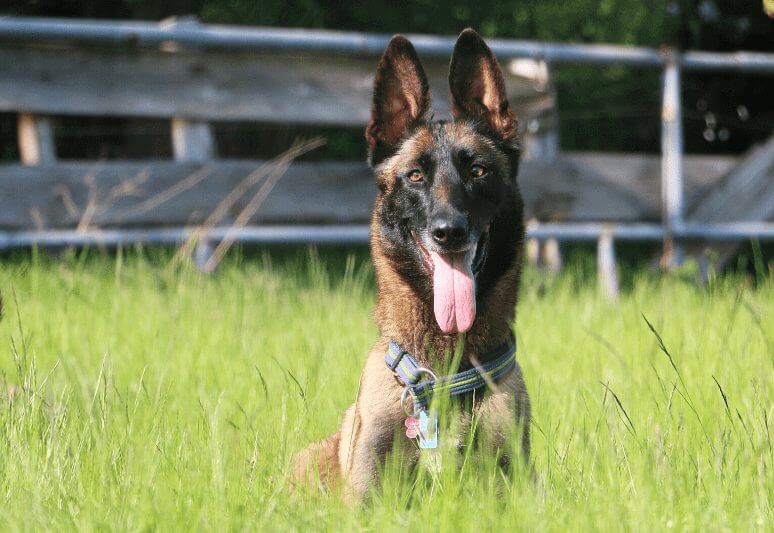
The Belgian Shepherd Malinois type, one of the 4 recognized variants of this breed, is a dog selected in present-day Belgium but with origins dating back to the shepherd dogs present in Northwest Europe.
It is no coincidence that it is very similar to the German shepherd dog in appearance, from which, however, differs in several details.
Malinois males can measure 24.4 inches (ca. 62 cm) in height at the withers while females can reach 22.8 inches (ca. 58 cm).
The ideal weight for these specimens should not exceed 66.1 pounds (ca. 30 kilogram), clearly in proportion to the animal’s size.
The first standard for this Belgian Shepherd was set in 1894 despite the heated debate about it, but only in recent decades has this breed regained value and popularity that apparently faded.
Very well adapted to act as a guard dog, the Malinois is also an excellent working dog, serving various law enforcement agencies, rescue, and recovery teams, as well as fulfilling its ancestral task: that of a shepherd.
This breed is characterized by an extremely lively and vital temperament, full of energy and very sharp intelligence.
Precisely for these reasons, however, it requires serious and rigorous training, led by the firm hand of a master who knows how to impose itself as a true leader of the pack.
If educated and socialized properly, in addition to being an excellent guardian, the Belgian Shepherd Malinois will also prove to be a very affectionate member of the family.
Belgian Malinois Dog Guarding Aptitude
Dog is extremely dedicated to the master and the family, which will defend to the end and will not fail to warn in case of need.
The Malinois shepherd is not a mistrustful or anti-social dog, so what will turn it into a perfect guard dog will be specific training, able to refine its attitude to guard.
Belgian Malinois Dog With Children
The Malinois madly loves children, his favorite playmates, and his protectors par excellence.
For this reason, however, it must be socialized and educated properly, so that it does not become too exuberant or overprotective of them, chasing (for fun) all the children it sees running around or mistaking a playful interaction as a danger to its little friends.
Belgian Malinois Dog With Strangers
The Belgian Shepherd Malinois is not particularly intolerant of strangers, perhaps, even more, the opposite.
It is, in fact, a lively and curious dog, which rather than distrust, is likely to show interest in a stranger.
The fact remains that this is an extremely intelligent breed with ever-stretched senses, so it will not be difficult for such a dog to sense imminent danger.
Belgian Malinois Dog With Master and Family
The Malinois truly loves its family, starting with the owner and ending with all other members.
In fact, with them, he establishes a relationship of mutual trust, affection, and loyalty, characteristics that clearly distinguish him from relationships with other figures.
Within the family, this dog fits perfectly, proving to be an excellent pet companion.
Belgian Malinois Dog With Other Dogs
The Belgian Shepherd Malinois proves to be a rather friendly dog towards its four-legged friends, being neither a particularly prevaricating nor aggressive animal.
Above all, if socialized correctly, the Malinois will bring out its more sociable and cooperative side, both with dogs that are strangers to him and with those within the family.
Belgian Malinois Dog Aggressiveness
The Malinois is anything but an aggressive dog: endowed with excellent self-control and extraordinary intelligence; it is really difficult for this breed to be dangerous except in cases of emergency.
It does not have a strong tendency to bite nor a strong predatory instinct; it can also be easily educated and corrected in its behavior depending on the situation.
3. German Shepherd
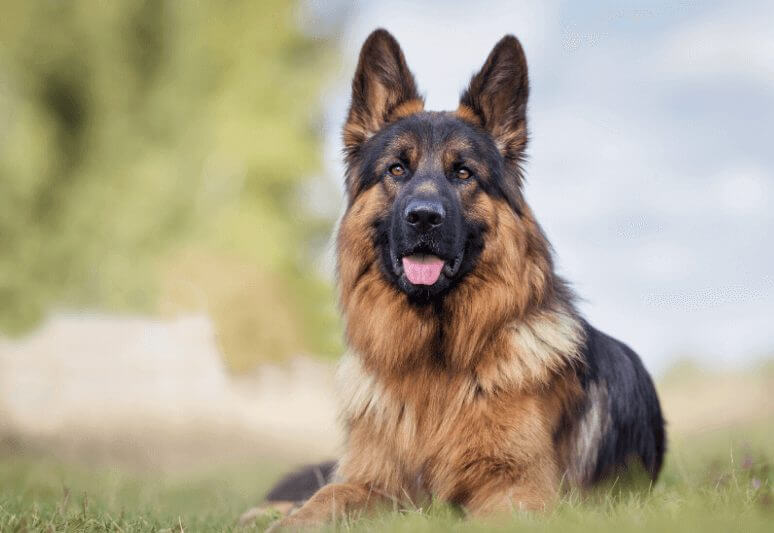
The German Shepherd Dog, generally known as the German Shepherd or Alsatian Shepherd, is probably the most famous guard dog in the world.
Selected at the end of the nineteenth century from native shepherds of the Germanic area, this breed was officially recognized in 1901, and since then, its popularity took off.
In fact, the German Shepherd is not only an excellent guard dog but an extraordinary working dog in general.
There are very few areas in which this magnificent dog has not been used, and its physical fitness, incredible intelligence, and balanced character have made it globally appreciable.
Males of these animals reach 25.5 inches (ca. 65 cm) at the withers and 88 pounds (ca. 40 kilogram) in weight; females usually stop at 23.6 inches (ca. 60 cm), with a maximum weight of about 70.5 pounds (ca. 32 kilogram).
The German Shepherd dog represents one of the best choices if you want to adopt a guard dog just because of its great versatility.
In fact, this animal is able to protect you, your loved ones, and your property by watching over its territory non-stop.
This dog with great physical and mental skills can physically overpower anyone who threatens him but with the right temperament to discern in which cases to attack and in which not.
The German Shepherd can also be initially suspicious of strangers, but if well trained and socialized from an early age, can also be the most sympathetic of playful, extremely attached to his family and loved ones.
Obviously, it needs a strict upbringing and a capable owner.
German Shepherd Guarding Aptitude
The German Shepherd is an excellent guard dog because of its attachment to its owner and its territory, which it defends and protects adamantly.
Its shepherd spirit, always on the alert, makes it an almost perfect natural guardian, which, however, will have to be socialized and educated in order to prevent its distrust from developing excessively.
German Shepherd With Children
The German Shepherd is an affectionate and patient dog towards children, whose presence it will not disdain but which, above all, it will take care to defend obstinately.
The intelligence and balance of these dogs will allow the owner to instruct him in an impeccable and quick way on how to behave with the children.
German Shepherd With Strangers
The German Shepherd is also a watchdog that, rather than an innate distrust of strangers, shows a true, almost analytical interest.
If the stranger in front of you is perceived positively, he will show good manners and respect, especially if introduced by the owner himself.
Otherwise, and do not doubt the discernment abilities of these dogs, the German Shepherd will act without hesitation.
German Shepherd With Master and Family
The same German Shepherd nourishes an immense affection in the comparisons of the own beloved ones, unbalanced obviously in the regards of the own trusted master.
Respect and loyalty will be a must for these dogs, but depending on the family members, they will then be more or less cuddly, playful, willing to obey, and whatever else.
A perfect family dog whose center of gravity is always the owner.
German Shepherd With Other Dogs
The German Shepherd is a balanced dog and tends to be respectful towards his peers, showing excellent qualities of tolerance and sometimes sociability.
The fundamental thing is to socialize the German Shepherd puppy early to learn to relate properly with other dogs and not bring out too much of its dominant streak, although present as in many large dogs.
German Shepherd Aggressiveness
The German Shepherd’s intelligence and discernment make it an extremely reliable dog and not at all aggressive IF properly trained.
It has no predatory instincts, does not easily resort to biting, knows what a real threat is, and will not attack anything or anyone without a valid reason.
All of this, as mentioned above, as long as you socialize and train rigorously.
4. Doberman Pinscher
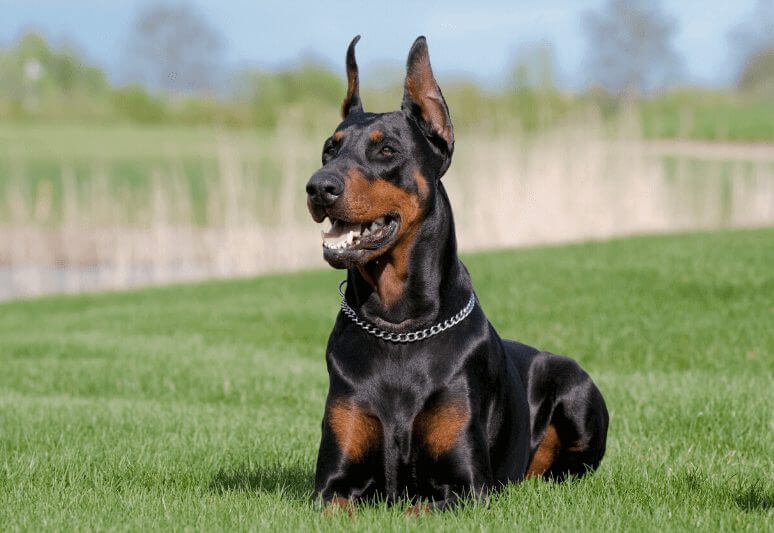
Another famous German guard dog is the Doberman Pinscher, selected in the mid-nineteenth century just for this purpose.
Its creator, in fact, selected this breed by crossing different canine specimens, obtaining what, in the end, turned out to be a beautiful animal, strong and functional for different purposes.
The Doberman is definitely an awe-inspiring dog, at least physically.
Males can reach 28.3 inches (ca. 72 cm) at the withers and weigh up to 99.2 pounds (ca. 45 kilogram), while females reach 26.7 inches (ca. 68 cm) with a maximum weight of 77 pounds (ca. 35 kilogram).
The slender but muscular build, the elegant but dangerous-looking features, and the protective attitude of this dog have contributed to the stereotype that circulates about this breed.
Dobermans are actually not fierce and aggressive dogs, especially if socialized from a young age and trained seriously and competently.
However, what is true is that because of the deep love that binds them to their families (especially children), they will not hesitate for one second to fight for the safety of their master and his loved ones.
And in these cases, yes, the Doberman does indeed prove to be an unpleasant encounter.
This is not the reason why this breed should be judged as “bad” or unreliable, especially considering the intelligence it can boast and the good versatility for which its specimens are still employed.
To adopt a Doberman and make it an impeccable guard dog and companion, however, requires a lot of dedication and a fair amount of firm wrist, not common to all dog owners.
Doberman Pinscher Guarding Aptitude
The Doberman is perhaps one of the guard dogs par excellence, with its extraordinary capacity for attention and the unwavering dedication it shows towards its master.
However, it will expect orders and signals that are very precise with respect to its tasks; otherwise, its territoriality and distrust could result in excesses.
Doberman Pinscher With Children
The Doberman is a dog that generally likes the little ones of the family, knows how to play with them quietly, and considers them as puppies to be protected.
However, it is not particularly patient and tolerant of unruly children who do not respect its space, which is why the dog must be socialized with care and the child educated to respect the animal.
Doberman Pinscher With Strangers
The protective instinct of the Doberman is particularly developed, which makes him quite suspicious of any presence that is not at home.
The stranger should always be introduced to the dog by the owner and, once the honors are done, the latter will know how to be friendly and sometimes playful.
In order to make room for this more tolerant side of the Doberman, the owner will have to educate and socialize the dog to interact in order to avoid the development of hostile or excessively dominant tendencies.
Doberman Pinscher With Master and Family
The same can be said for the Doberman pinscher, which will love its family without limits, especially if properly accustomed.
It is a dog in need of constant and generous demonstrations of affection from all the members of the pack, even if, not even to say it, his favorite will always remain the master.
Doberman Pinscher With Other Dogs
The Doberman is certainly not one of the breeds recognized as being more sociable and open to interaction with other dogs.
Especially in the case of specimens of similar size and of the same sex, clashes and hostility may occur, especially when it comes to males.
The solution to blunt this temperamental side of them, although it is unthinkable to eliminate it, is early socialization.
Doberman Pinscher Aggressiveness
The Doberman is not a naturally aggressive dog but can become so if in danger, to establish a dominant relationship, or if poorly trained.
In all of these cases, the breed shows a greater propensity than others to attack, but all of these can be avoided (apart from the first) if the dog is properly trained and socialized.
5. Cane Corso
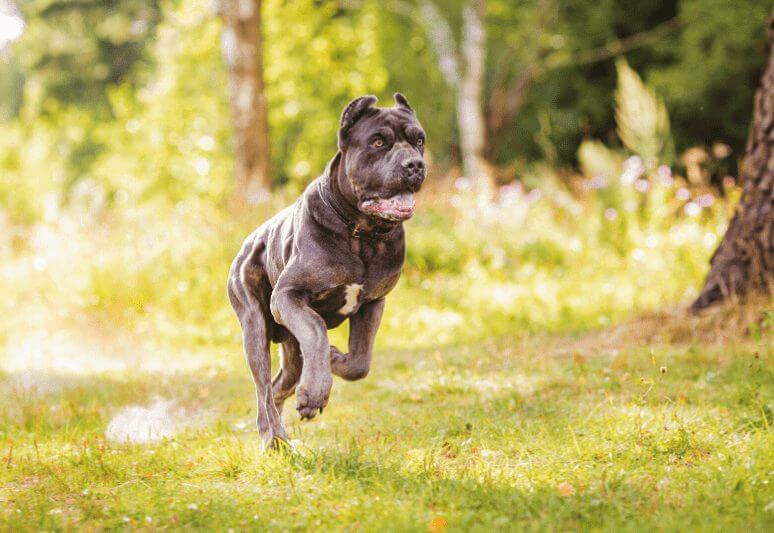
The Cane Corso is a dog breed native to the Italian peninsula, of ancient and rural origin and, at least once, extremely widespread throughout Italy.
The Corso is a molossid that was widely used for personal and property defense, for herding flocks and herds, as well as for guarding.
Some ancient Roman testimonies also recount him as a dog used in warfare.
In more recent times, it gained “bad” fame for having proved to be one of the dogs preferred by the Italian southern brigands, by whom it was exploited and employed not only for personal defense but also for the fulfillment of cruel and ruthless cruelties.
The physicality of these dogs, up to 26.7 inches (ca. 68 cm) tall and weighing between 50 and 60 kg (110.2 and 132.2 pounds depending on the sex of the animal), has made them feared and mistrusted, although their temperament is much more balanced than you might think.
The “de-ruralization” of the mid-twentieth century drastically decreased the breed’s numbers, which regained increasing popularity starting in the following decades, especially in Southern Italy.
The Cane Corso is a perfect watchdog, tireless and unwavering protector of its territory.
Consider, however, that it is not really a companion dog and, outside of its owner, it is not taken for granted that it will bind itself affectionately to other members of the family.
It is an animal naturally wary of strangers and other dogs, with whom it shows little sociability and familiarity.
For these reasons, the (hopefully knowledgeable and experienced) owner must take care to socialize, educate and train the cane corso in this order, imposing strict and firm leadership.
Cane Corso Guarding Aptitude
The Corso is another guardian par excellence, no-frills, and quirky middle ground.
The pronounced territoriality of this dog precedes his fame, and for the property of the master is ready to fight to the last blood.
It is an attentive and relentless guardian, very serious in its duty and in need of a great deal of socialization not to become a constantly hostile presence.
Cane Corso With Kids
The Corso is not really a dog suitable for children. In spite of the affection it can develop towards them, not to mention its protective instinct, it is not a very patient dog towards them.
Its physical size and its natural tendency to impose make it incompatible with children’s interactions, which must be supervised and conducted by the owner.
Cane Corso With Strangers
The Corso is a dog that is extremely jealous of its territory, and strangers just can’t digest it.
Faced with a stranger approaching his property, he is likely to bark ferociously and show signs of hostility, revealing his propensity for an aggressive defense.
Through careful socialization undertaken by the owner, these dogs can learn to distinguish the danger between different situations and learn to tolerate a stranger (invited) within their territory.
Cane Corso With Master and Family
The Corso dog, especially if socialized properly, can prove to be a true lover of family companionship.
He will love to receive cuddles and attention from his master and the other members of the family, and through these, he will be able to establish stable and lasting bonds with all the members of the “pack.”
Great attention must be paid by the owner, the true center of the dog’s affections, to ensure that the cane corso knows how to accept and recognize all his loved ones as entities to be protected and safeguarded at all costs.
Cane Corso With Other Dogs
The Corso is not a dog that enjoys the company of its peers.
At most, it can tolerate the presence of conspecifics and relatives, but peaceful coexistence is by no means assured.
He is by no means a social dog and should not be left in the company of other dogs without proper supervision and control.
Its dominant nature cannot be extinguished, only mitigated through generous socialization.
Cane Corso Aggressiveness
The Corso is a dog that can easily prove aggressive even outside of its guardian duties, especially if poorly handled by its owner.
The Corso dog can be violent and dangerous with strangers, other dogs, and other animals (to which it is attracted by virtue of its predation instinct).
In order to avoid this, the owner must train it in a firm, serious and rigorous way.
6. American Akita
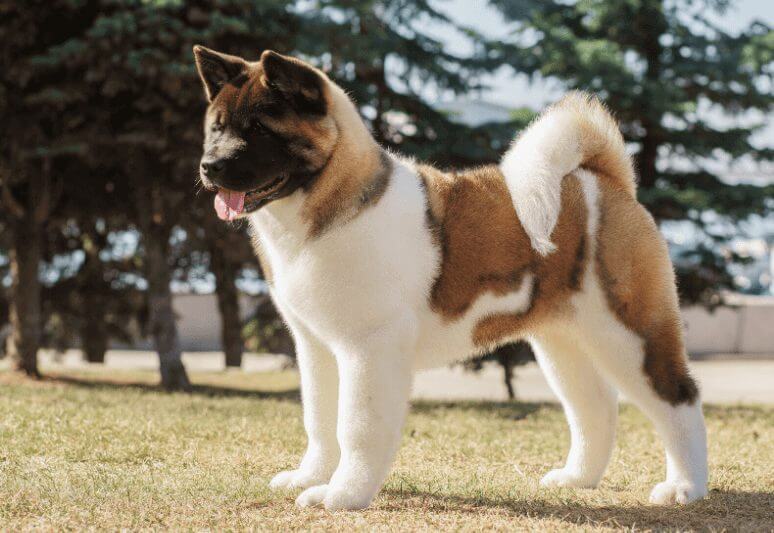
The American Akita is a breed in its own right that has been recognized fairly recently.
Its lineage clearly resembles that of the Akita Inu, a very popular Japanese dog with ancient origins and unique characteristics.
The American Akita began to differentiate itself from its Japanese ancestor in the early 1900s when these dogs (originally used for hunting or guarding) were also exploited as fighting animals.
In order to make them more powerful and aggressive, they were crossed with European molossoid breeds and took on the features that we know today.
They then spread to the West after the Second World War, and from there, also thanks to their magnificent appearance, they were bred with increasing intensity, while in Japan, the Akita breed was re-selected in the traditional direction.
The American Akita is a powerful dog with a strong constitution: males can reach a height of 27.9 inches (ca. 71 cm) and a weight of 132.2 pounds (ca. 60 kilogram), while females are 25.9 inches (ca. 66 cm) at the withers and 110.2 pounds (ca. 50 kilogram).
As watchdogs, they are almost perfect, but in order to insert themselves in an effective way inside the family nucleus (to which they will be very attached even if maintaining margins of autonomy), they need a rigid education.
It is not a naturally sociable dog, neither with its own kind nor with strangers, from whom it is categorically distrustful; in order to bring out its character qualities in the best possible way, it is, therefore, a good idea to socialize it from an early age.
The important thing is not to be fooled by the wonderful aspect of this animal: the American Akita is a proud, strong, and loyal dog, but it must be entrusted to expert and competent hands to demonstrate its full value.
American Akita Guarding Aptitude
The American Akita, while having a pronounced individuality, is very devoted to its good master and extremely territorial.
It is not a particularly tolerant guardian (and perhaps for this reason also very much appreciated), and there is a need for the owner to instruct him properly regarding the specific situations in which to react.
It is not a particularly tolerant guardian (and perhaps for this reason also very much appreciated), and there is a need for the owner to instruct him properly regarding the specific situations in which to react.
One’s own space and master still remain mantras for the American Akita.
American Akita With Children
The American Akita can prove to be an extremely protective and affectionate dog of the human puppies within its family, but this does not mean that it can always get along with them.
It is, in fact, a breed not very patient and very jealous of their own space, which must not be exceeded and prevaricated even by children.
American Akita With Strangers
The Akita is an extremely suspicious and territorial dog; it follows that the relationship with strangers is not really his strong point.
He knows how to make his state of mind understood and, if he is not comfortable, he gives a clear sign of his hostility.
Only the owner’s intervention can prevent this natural tendency of the dog from turning into something worse.
American Akita With Master and Family
The American Akita, while not denying its nature as an autonomous dog, is very attached to the family that knows how to respect and support the most natural sides of his temperament.
Cuddling and attention will be welcome but without overriding some of her needs.
However protective and attached to the family he may be, it is good that the owner establishes a clear relationship of dominance with the Akita so that the dog does not consider himself above his own affections.
American Akita With Other Dogs
The American Akita, also by virtue of its strong territoriality, is not suitable for the company of other dog breeds.
His past selection also sees an incitement to aggression towards other dogs (given his use in combat), and he does not like canine presences foreign to him, either inside or outside the home.
Only through proper socialization can you prevent it from showing hostility to dogs outside the family unit regardless.
American Akita Aggressiveness
As much because of its past as because of its hunting vocation, the American Akita is a dog that can develop aggressive behaviors.
While these tendencies are not too extreme, they are easily detected and must be corrected at a young age through proper socialization as well as through proper training.
7. Argentine Dogo
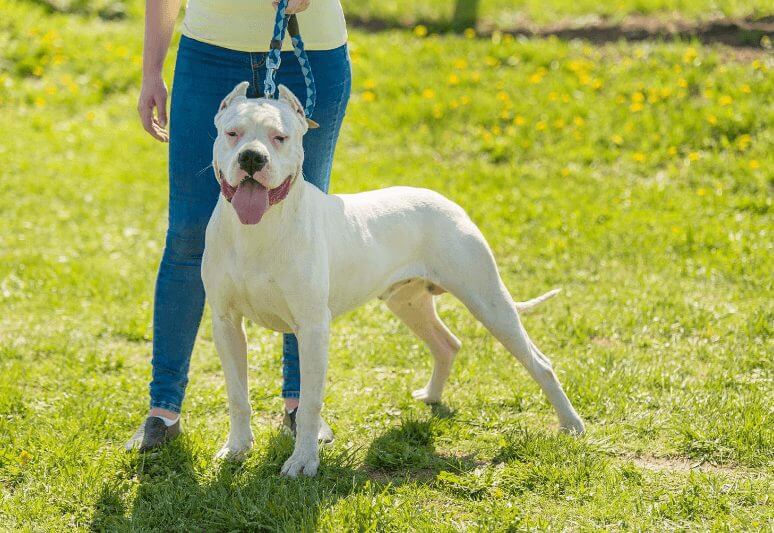
The Argentine Dogo is a medium to large-sized dog originating, as you can easily guess, from the beautiful and wild Argentina.
The creation of this breed dates back to the first half of the twentieth century when Dr. Antonio Nores Martìnez proceeded to cross a series of native and European breeds.
It actually started from the Perro de Pelea Cordobés, a dog derived from mixed mating between European molossidae used for fighting.
Starting from these specimens, he subsequently selected another breed with harmonious forms, a strong physical performance, without the typical prognathism of molasses but with an equally bold temperament.
The result of these experiments was the Dogo, the white dog we all know and which, although already complete in 1947, was not recognized until 1973.
The males of these dogs can be close to 26.7 inches (ca. 68 cm) in height and 99.2 pounds (ca. 45 kilogram) in weight, while the females respectively 25.5 inches (ca. 65 cm) at the withers and 88.1 pounds (ca. 40 kilogram).
However, what does not change is the defensive attitude of these dogs, perfect for protecting the owner or his property from attackers.
However, the Dogo is not at all an easy dog to handle, both in terms of normal human relationships outside the family unit and in terms of other dogs.
In this case, it is a mistrustful and dominant breed, which does not tolerate presences that are not known to him.
The same family relationships turn out to be complex and diversified when it comes to the Argentine Dogo. Although it becomes somewhat attached to all members of the nest, only to one (and if educated correctly), it will show itself to be submissive like a top dog.
It should also be mentioned that the Argentine Dogo has a very strong predatory instinct due to its use as a hunting dog.
Argentine Dogo Guarding Aptitude
The Argentine Dogo turns out to be a dog particularly suitable for guarding by virtue of its strong dedication to its owner and family.
Presences that do not fall into this category are not particularly welcome to the Dogo, who needs proper education if you do not want him to become excessively territorial and hostile.
Argentine Dogo With Children
The Argentine Dogo develops a strong affection towards its family unit, although with different degrees and intensity.
It can turn out to be a good friend and protector of the children, provided that it is thoroughly socialized in their presence and strictly educated with respect to the behaviors to be kept.
Interactions between the two parties should always be monitored.
Argentine Dogo With Strangers
The Argentine Dogo is an excellent watchdog and self-defense dog, so as you can imagine, he doesn’t particularly get along with strangers.
Even though the selection of these dogs has been very strict towards man, the dominant tendency of the Dogo can always manifest itself and lead to aggression.
For this reason, it is essential that the owner makes it clear to the Dogo that he will decide whether a stranger is to be considered friendly or hostile, not the dog.
Argentine Dogo With Master and Family
The Argentine Dogo normally develops a strong sense of attachment to the family unit, which it is committed to guarding and protecting.
Also present in it is the tendency to differentiate the level of interactions depending on the members, of which the undisputed favorite will always be the master.
Therefore, the task of the pack leader will be to educate the dog to respect and submit (even if only partially) to the other personalities within the family so that the Dogo does not develop domineering behaviors.
Argentine Dogo With Other Dogs
The Argentine Dogo is not an appropriate dog for canine companionship.
While tolerating specimens of the same breed, relationships with other dogs must be limited and carefully controlled if placed in a true pack context.
His strong dominance can lead him to aggression, and the only way to smooth out this edge of his personality is to socialize him early.
Argentine Dogo Aggressiveness
Unfortunately, the Argentine Dogo is a dog that can prove to be extremely dangerous due to some of its aggressive tendencies.
Both for its mistrust and its pronounced predatory spirit, this animal can prove to be actually threatening, especially if poorly trained or poorly socialized.
A solid and firm education is necessary in these terms in order to avoid an aggressive drift of the Dogo, a dog however intelligent and reasonable.
8. Maremma Shepherd
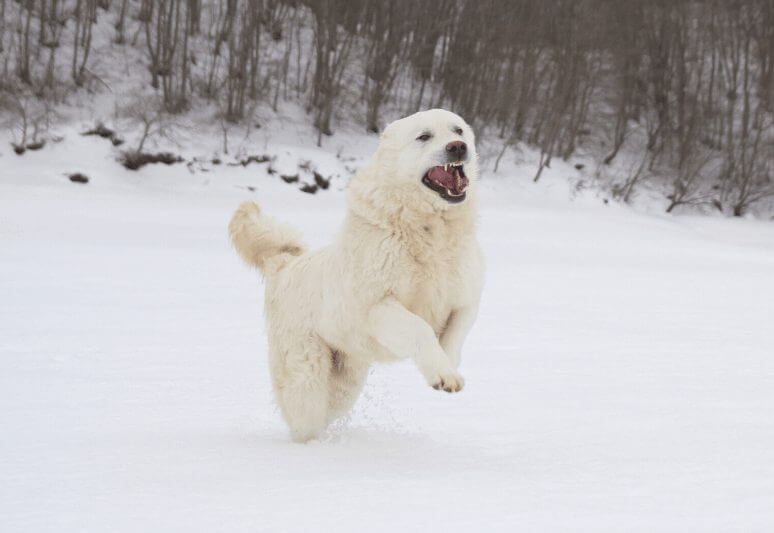
The Abruzzese Shepherd Dog is another breed of dog from guard typical of the italic peninsula, developed in times really ancient and arrived nearly intact up to the day of today.
There are different varieties of Abruzzese shepherd, of which the variant of Maremmano is the smallest one with its only 28.7 inches (ca. 73 cm) in height for males and 26.7 inches (ca. 68 cm) in height for females, with an estimated weight of about 40 or 45 kg (88.1 and 99.2 pounds) depending on the sex.
I mean, we’re not talking about a pet to cuddle on your lap on the couch at home.
The Abruzzese Shepherd Dog is a dog of ancient origins, rustic in appearance and strong health, beautiful and proud in appearance and temperament without frills.
This “white guardian” is, in fact, a mountain dog and, as such, will always keep its dignity, its pride, and its independence well intact, properties from which it will never separate even for its own master.
However, this does not mean that it is an impossible dog to manage: it must only be educated to obedience with respect to the tasks dictated by the pack leader, who, however, will not be able to expect this animal to please him in every little request.
This being clear, we are left with a dog that tends to be docile and with mild manners, polite with the family but never servile.
The Shepherd Maremmano then, back from a millennial past as defender of the flocks in transhumance, is a formidable guardian.
He does not tolerate strangers invading his territory and approaching his loved ones, but he is able to tolerate them well and prove to be quite sociable with other dogs (with whom he has been accustomed to working together since his origins).
In short, the Abruzzese Shepherd Dog is an excellent guard dog that requires an owner who is aware of its character and a good experience to manage it.
Maremma Shepherd Guarding Aptitude
The Abruzzese Shepherd Dog is an impeccable guardian, incorruptible and immovable.
It will not tolerate any kind of outside presence in what it perceives as its territory, nor will it allow any unwanted person to come near its master and his property.
Correct socialization is necessary to make the dog understand which is the right behavior to keep according to each case; however, do not think to make him playful and friendly with everyone.
Maremma Shepherd With Children
The Maremma Shepherd is a dog that, if educated correctly, will prove to be gentle, docile, and protective towards children.
By virtue of its proud and autonomous temperament, they too must be educated to respect the dog, which in case it feels taken little seriously could lose its patience despite its intellect.
Maremma Shepherd With Strangers
The Maremma Shepherd is very little courteous in the comparisons of the strangers that it usually welcomes to thundering barks.
The nature of this dog cannot change, and the millenary selection of these guard dogs has given almost impeccable results.
The only “weapon” available to the owner is early socialization and education of the dog so that, at a nod from the owner, the dog knows how to calm down in front of a stranger.
Maremma Shepherd With Master and Family
The Maremma Shepherd is a tame and friendly family companion who may not be lost in dispassionate displays of affection but who really cares about his master and his loved ones.
Do not think of forcing his hand to make him become a docile and cuddly lap dog because it is not so: the most sincere and important demonstration of affection that the Maremma Shepherd will have is respect and loyalty.
Maremma Shepherd With Other Dogs
On the contrary, the Maremma Shepherd can prove to be a rather tolerant breed towards other dogs.
His presence is naturally very cumbersome and could cause some problems if poorly managed, but the spirit of cooperation with other dogs is inherent in his ancestral nature.
It too, however, must be educated in tolerance and respect through careful childhood socialization.
Maremma Shepherd Aggressiveness
The Maremma Shepherd can be aggressive.
In most cases, this tendency is registered with strangers outside the family nucleus, but it can also externalize itself towards an owner who does not know how to manage it and has not been able to impose himself on it with due respect and the necessary pulse.
This breed is totally devoid of predatory instincts and firm temperament, but a good education is necessary to keep it calm and not hostile outside of its duties.
9. Giant Schnauzer
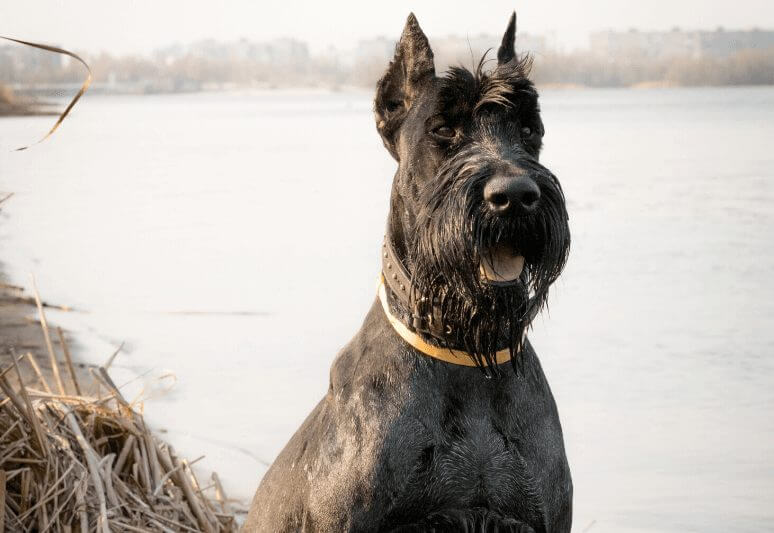
The Giant Schnauzer, whose original nomenclature is Riesenschnauzer, is a large German working dog particularly suited to the role of guardian.
Its selection was actually made starting from Tyrolean shepherds and Bouvier des Flandres, but over the centuries, this breed was definitively established in Germany, more precisely in the area of Munich.
Although the breed integrity was established as early as 1880, this large moustachioed dog of brewers and butchers was first showcased in 1922.
Since then, it was officially recognized and employed in the most varied activities.
His size, oscillating between 60 and 70 cm (23.6 and 27.5 inches) with a weight between 35 and 45 kg (77. 1 and 99.2 pounds), and his severe appearance have clearly directed him towards more defensive careers.
In addition to being used as a guard dog, the Giant Schnauzer is also used as a police dog or as an aid to law enforcement, especially because of its aptitude for work and its enviable physical performance.
However, the temperament of the Riesenschnauzer is quite mild and balanced, certainly determined and brave but also sweet and caring.
The affection, dedication, and patience he shows towards his family have made him a very desirable dog for Pet Therapy as well.
However, to be properly managed requires a master with a firm and decisive hand, never exaggerated in its impositions but able to impose itself as the only consistent leader of the pack.
Giant Schnauzer Guarding Aptitude
The Riesenschnauzer lends itself as a well-balanced and versatile guard dog, particularly attached to its owner and family.
His tolerance of foreign presence is good, however, but don’t think for this reason that he can’t distinguish between who is a danger and who is harmless.
The intelligence, character balance, and good self-control of the Giant Schnauzer do not preclude, however, the need for proper education by the owner.
Giant Schnauzer With Children
The Giant Schnauzer is capable of developing a relationship of great affection, attachment, and protection towards young children.
It needs to be socialized and educated to best respond to this type of companionship, but once done, it will be a truly reliable, playful, and patient dog in interactions with children.
Giant Schnauzer With Strangers
The Riesenschnauzer, as good a guardian as can be, keeps an attitude of healthy distrust towards strangers, neither too permissive nor too hostile.
In fact, it is a dog with sharp intelligence and an always lively attention, so at the slightest signal (both positive and negative), it will lower or raise its guard.
In order to achieve this balanced result, it is wise for the owner to socialize and educate the Giant Schnauzer properly.
Giant Schnauzer With Master and Family
The Giant Schnauzer knows how to establish a relationship of deep affection and love with its family.
It is, in fact, an affectionate and faithful dog with all his loved ones, capable of showing respect and love towards everyone.
Especially if properly socialized by the owner, the Riesenschnauzer will prove to be an excellent family dog.
Giant Schnauzer With Other Dogs
The Giant Schnauzer can adapt well to the presence of other dogs, both inside and outside the household.
Despite a certain breed-specific dominance, which is mostly revealed with large dogs of the same sex, it can effectively be socialized to tolerance, politeness, and friendliness towards its peers.
Giant Schnauzer Aggressiveness
The Riesenschnauzer is a dog that is not very prone to aggression, but it can prove to be particularly dangerous to attackers and wild animals.
Its predatory instinct is, in fact, moderately developed, but this, as well as a natural tendency to imposition (which can degenerate into aggressive hostility), can be easily controlled through good training.
10. Rottweiler
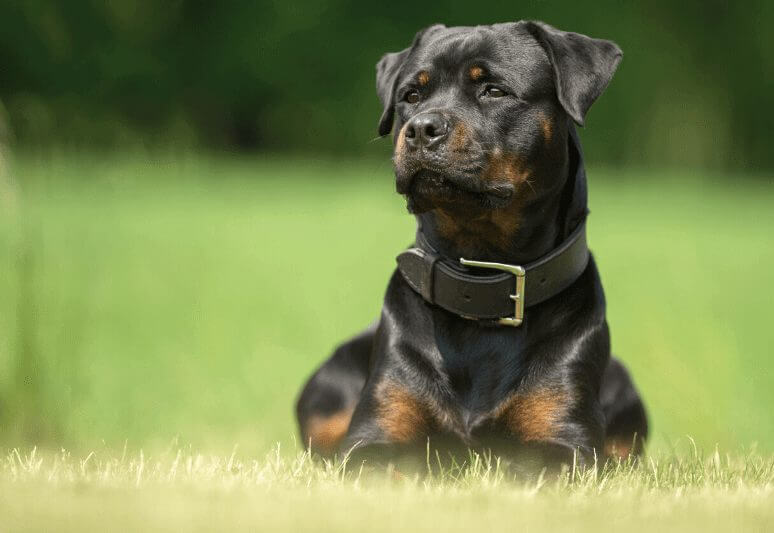
Not many introductions are needed to introduce the Rottweiler, one of the most famous and globally known dogs.
Its forerunners have very ancient origins, even dating back to the ancient Romans, although its consecration took place in the German city of Rottweil, from which it then took its name.
The herdsmen and butchers of the German town particularly appreciated these dogs for their guardian qualities: incredibly loyal, tenacious, strong, and brave.
Crossing to these specimens, other breeds obtained what today we all know as Rottweiler, whose racial bond is well defined by precise standards.
Male specimens boast a maximum height at the withers equal to 26.7 inches (ca. 68 cm) and a weight of about 110.2 pounds (ca. 50 kilogram), females, even though they are smaller, reach a maximum height of 24.8 inches (ca. 63 cm) and a weight of 92.5 pounds (ca. 42 kilogram).
In short, the Rottweiler is certainly not a one-room dog.
In addition, this dog is not among the easiest to handle and breed, despite the soft dough it is made of underneath the much harder outer bark.
In fact, the Rottweiler is a dog with a very strong character and temperament, decisive and authoritative, always ready for action and the performance of his duty.
Its aptitude to the defense and to the guard have stigmatized it as one among the many dangerous dogs, forgetting that such dangerousness (certainly existing) depends on the greater part of the cases on the training and the care given to it by the master.
So it takes a firm hand, rigor, awareness, and experience to properly raise a Rottweiler that turns out to be an incredibly loving and caring family dog if treated as it should.
Rottweiler Guarding Aptitude
The Rottweiler is an extremely well-suited dog for the role of guardian, and its natural setting suggests that orientation.
It is a breed with a strong sense of protection towards people or property. It will not hesitate to defend under any circumstances and resort, if really necessary, to brute force.
In order to mitigate this strong temperament of the dog, good education and equally good socialization will be necessary.
To best educate the Rottweiler on his guardian duties, it would also be good to train him specifically for this purpose.
Rottweiler With Children
The Rottweiler is a large guard dog who turns into the most tender of lambs when dealing with children.
The little ones inside the family nucleus are his favorite protégés, faithful friends, and inseparable playmates.
Having children in close contact with a Rottweiler is not a risk factor, especially if the dog is socialized, polite, and regarded by its owner properly.
Rottweiler With Strangers
The Rottweiler is endowed with a strong protective instinct and will allow anyone to harm their loved ones for no reason in the world, which is why it tends to be a wary breed.
Although not naturally hostile towards strangers, it is necessary that the specimens are socialized to foreign human presences since they are puppies so as to be controllable by the owner.
Rottweiler With Master and Family
The Rottweiler is a true family pet: it loves its human relatives dispassionately and shows them unconditional affection and loyalty.
The owner will always be the center of his world, and from him, the dog will expect love, understanding, balance, but also firm leadership.
If these requirements are met, this breed proves to be perfect for family life.
Rottweiler With Other Dogs
Other dogs are certainly not the favorite company of the Rottweiler, who should always be supervised in terms of interactions with his peers.
The natural diffidence, the instinct of prevarication, and the authority typical of this breed make the Rottweiler’s relationships with other dogs more complicated and not always sociable.
For these reasons, such specimens should always be socialized prematurely and, when necessary, corrected for harmful behavior.
Rottweiler Aggressiveness
The Rottweiler is an extremely protective and sometimes possessive dog, but not really aggressive.
If educated and trained correctly and mitigating his temperament, it will also result in greater control in the dog’s reactions and behaviors in the face of stressful elements.
Considering its physical strength and the extent of its bite, while possessing good intelligence, the Rottweiler must be well behaved and sometimes controlled.
Conclusion: What to Keep in Mind Before Adopting a Guard Dog

Guard dogs come in all shapes and sizes, but the best family guard dog is one that makes you feel safe.
Before adopting an animal, make sure to consider what their personality will be like when they’re living with children and other animals.
A good guard dog needs plenty of mental and physical stimulation.
So, make sure you are willing to dedicate time each day (at least 30 minutes) towards playing and walking them at least twice per day before getting a pet.
As always, I hope this article has been informative and helps guide your decision-making process when it comes time to adopt a new pet into your family.
If you liked this article on guard dogs for families, please share it so others can find out about these amazing breeds who love nothing more than protecting those they care about
Resources:

